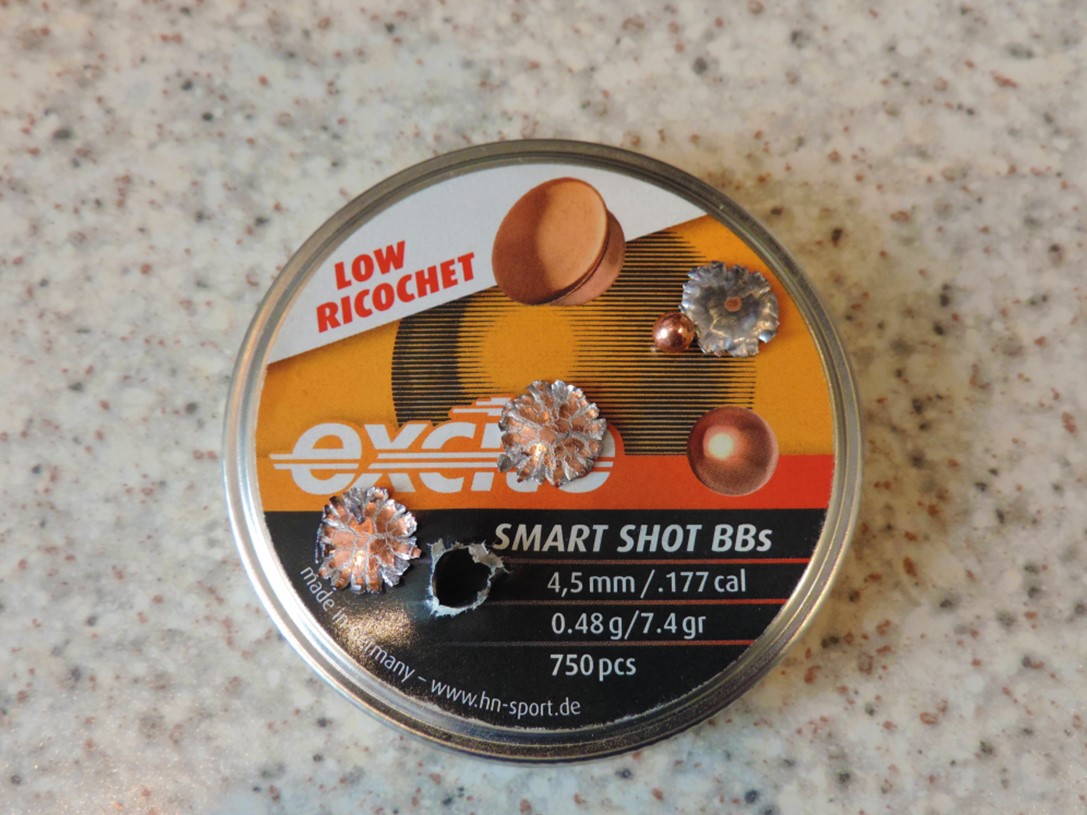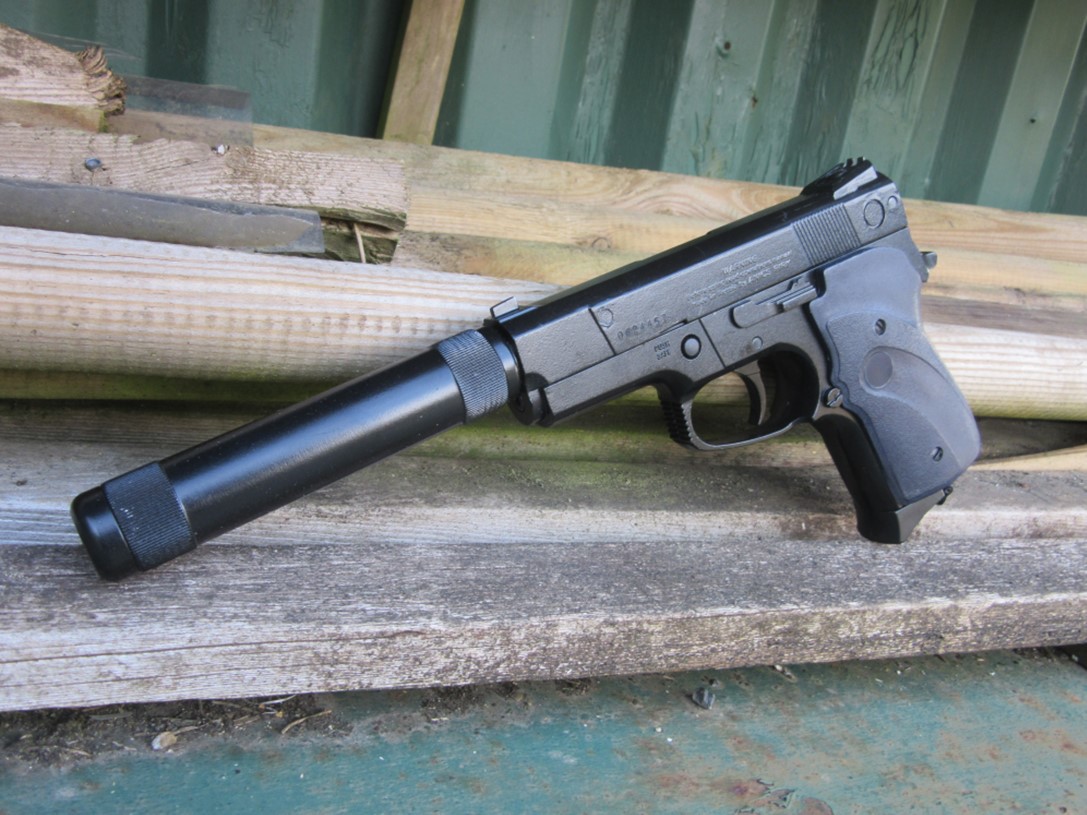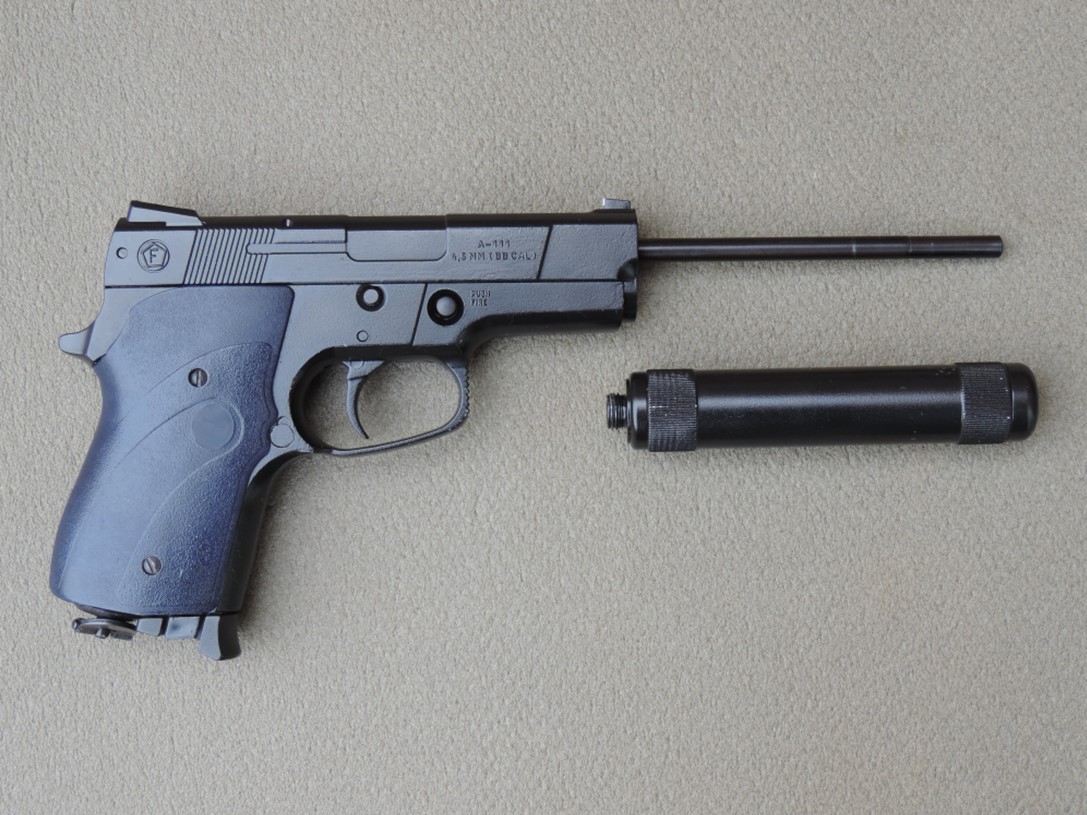John Milewski explores the Long-Barrelled ANICS this month to conclude his series on the iconic pistols
In the first part of this short series, I mentioned there were two further models in the ANICS 100 range – the A-111 and A-112. The former was a compact little pistol and the other a longer variant that loosely resembled the Browning Hi-Power. Both had an attractive forward curve to the magazine lip that helped to keep your grip consistent.


The robust ANICS A-111 LB has a long barrel that is hidden by a faux silencer.
See how the copper-coated lead balls have deformed. They also went through this tin as though it were paper!
ANICS produced a number of ‘Special’ models termed LB for ‘Long Barrel’. One model was based on the A-101 and the other was the A-111 LB. These pistols were factory-fitted with exceptionally long barrels, cleverly hidden within a dummy suppressor or silencer shroud. The thin barrel reaches almost to the end of the silencer’s muzzle, and in my opinion, these pistols certainly have the ‘cool factor’, but then I was brought up on a diet of James Bond films, and The Professionals was my favourite TV series in the days when we only had three TV channels to choose from. The dummy silencer can be screwed on or off, but the pistol looks naked without it in place, and the long, thin barrel is at risk of damage if left uncovered. CO2 works best as a power source in longer barrels and ANICS advertised the muzzle velocity of the A-111 LB as 180 metres per second, or approximately 590fps in old money.
SPARE MAGAZINE SUPPLIED
Due to the presence of the long barrel, the LB models were presented in a wider case than standard models and came with a spare magazine and manual as standard. The spare magazine is very useful for reloads, or in case the original develops a fault, and spares should really be supplied with all CO2 repeaters because the pistol cannot function without a magazine. A magazine from the A-101 will fit the A-111 and A-112 series and vice versa, so if you own one or more ANICS pistols, you can accumulate a good supply of spare magazines for range sessions.
The A-111 and A-112 were fitted with a simple adjustable rear sight. It was a pressed piece of steel with a ‘U’ notch fixed in place with a screw. Adjustments could be made by slackening off the screw and moving the sight in the desired direction before tightening the screw. Not the most precise way of adjusting sights, but certainly a welcome feature when compared to the non-adjustable sights found on most CO2 ‘replica’ BB pistols. I added a dab of white Tippex fluid to the rear of the front blade to help me pick it up against a dark background, and then I set off to the range for some testing.
 With the dummy silencer removed, the length of the extended barrel can be appreciated.
With the dummy silencer removed, the length of the extended barrel can be appreciated.
IN USE
General handling of the A-111 LB I tested was pleasant. I can imagine the compact standard A-111 being as pointable as the A-101. In fairness, I didn’t find that the extended barrel and its faux suppressor took away from the handiness of this pistol because they are light and do not adversely impact handling. Sights can easily be seen over the top of the silencer, unlike some replicas, so thought has gone into the design.
The grips are a soft-textured synthetic material that feels smoother to the touch than the squarer grips on the A-101 series. They were noticeably more comfortable around the web of my hand between thumb and forefinger because this area was rounded rather than square. I’m not overly keen on their look and would have preferred a surface akin to a pair of U.S. Hogue grips. However, I do accept that the ANICS were budget pistols and the grips do their job as intended.
THE WORLD’S MOST POWERFUL BB PISTOL?
Over the chrono’, the longer barrel helped to achieve an average muzzle velocity of 508fps with Excite Smart Shot copper-coated lead ball. This equates to an incredible 4.2 ft.lbs. from a BB pistol. The copper-coated ball did what it says on the tin and flattened rather than ricocheted. They also went through a pellet tin like paper at the short range I initially tested the pistol. Thanks to the adjustable sight, I was able to zero the pistol to hit centrally rather than having to aim off, so my first impressions of the A-111 LB were very favourable in terms of performance.
Increasing the distance to 15 metres outdoors, I hung an old soup tin in front of a steel backstop and commenced firing. Two magazines of 15 rounds later, and the tin was ventilated on all sides. I adapted my trigger technique and took up around 80% of the trigger pull weight swiftly before freezing the pull and concentrating on a smooth release as I pulled through the remaining 20%. This resulted in accurate performance downrange because my sight picture did not move about in the way it was prone to when I released the trigger with one long pull. With more practice, it may be possible to take up 90% of the weight before releasing the remainder. I ceased testing after around 90 rounds because my trigger finger was getting sore due to the long trigger pull!
STRIPPING THE A-111 & A-112
Firstly, ensure that there is no CO2 cylinder in place and the pistol is unloaded. Taking the A-111 apart is a lot easier than the A-101 series becuase all you have to do is push out the pin at the rear of the fake slide from right to left (the pin is wider at one end) and undo a locking screw under the muzzle. The top half of the pistol (fake slide) can then be raised and removed. This provides access to the working parts and you can see how the pistol operates. The mechanism is simple and consists of a sear that moves the barrel forward against spring pressure until its profile releases the barrel at the end of a long pull that feels like a double-action mechanism. The barrel then slams rearward and knocks open the valve, which in turn, discharges the uppermost BB or ball in the stick magazine, which had previously been fed into an opening toward the rear of the barrel. This simple mechanism has since been copied on the Umarex PO8 and Glock 19 non blow-back pistols.
Some owners have suggested removing the mainspring and stretching it to increase power or adding concentric shims in front or behind the mainspring to achieve the same outcome. In fairness, the A-111 and A-112 are capable of above average velocity and the LB models higher still, so my suggestion is to leave factory settings alone because the ANICS models are designed to be of above average performance out of the box. Compressing the spring further than intended will also result in a heavier trigger pull and increased stress on the pistol’s internals.
Overall, I like the idea of a long barrel hidden by a faux suppressor, and in this case, performance is enhanced over standard models. I’d have loved a session with one of these pistols after watching the latest episode of The Professionals back in 1980!